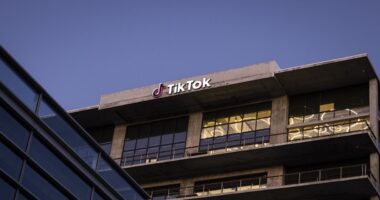
Real-estate companies are facing soaring costs to protect their variable debt against jumps in interest rates, with prices on some contracts jumping at least 10-fold this month from a year earlier.
Banks and other lenders often require real-estate firms relying on floating rate debt to hedge their exposure with so-called interest-rate caps. The caps are derivatives contracts, sold by the lender, in which companies receive a payment when an interest-rate benchmark—for example, the Secured Overnight Financing Rate—exceeds a certain level. Companies have to buy these caps after they secure new debt and risk defaulting if they violate that covenant.
The caps, which are also used in other industries, shield companies from sharp increases in rate benchmarks like SOFR or the London interbank offered rate, which underpin trillions of dollars of financial contracts, including corporate loans, mortgages and interest-rate derivatives. They limit borrowers’ interest costs and assure lenders that a risk potentially affecting their clients’ ability to service their debt is mitigated.
As the Federal Reserve continues its campaign of interest rate increases, some companies are looking for alternatives to the caps, for example by taking out fixed-rate debt instead or hedging their variable debt. Real-estate companies are struggling with cost increases for labor and building materials as well as slowing demand.
Prices for caps have surged in recent months as the U.S. central bank raises rates, most recently to a range between 3% and 3.25% in September. For a 4%, three-year $100 million interest-rate cap tied to SOFR—a standard deal size in the real-estate sector—prices averaged $2.2 million in October, up from $200,000 a year earlier and $45,000 two years earlier, according to Riverside Risk Advisors LLC, a hedge advisory firm. For a similar cap that covers two years, prices averaged $1.5 million, up from $50,000 a year earlier and $14,000 two years earlier, Riverside Risk Advisors said.
“Cheap financing is no longer a market reality for companies,” said Helen Kane, director of risk and exposure management at software provider Hedge Trackers LLC.
Armada Hoffler Properties Inc., a Virginia Beach, Va.-based real-estate investment trust that invests in office, retail and multifamily properties, in July extended the maturity on caps on $285 million in debt by about a year to 2024, Chief Financial Officer Matthew Barnes-Smith said. The company purchased the cap at a 1% threshold rate, he said, which means that it would receive a payment if its benchmark rate moves above 1%. The transaction also includes an agreement for the company to sell a different cap with a 3% threshold, which effectively reduces the cost of the new cap by as much as a third, he said.
Companies tend to buy and sell caps in one transaction with the same bank to avoid credit exposure. Banks usually include the planned sale along with the purchase in one contract, allowing companies to pay one net price and less than they otherwise would have paid to buy the new cap.
The extension means its debt will be fully fixed or hedged through 2024, limiting any additional interest-rate costs until then. The company since March recorded a significant increase in derivatives costs, Mr. Barnes-Smith said, but declined to provide specifics.
“We believe that potentially with the Fed, they will eventually slow down the rate increases and the uncertainty in the market will come out, making those derivatives slightly more attainable when ours mature,” Mr. Barnes-Smith said. The company held about $643.8 million in variable rate debt as of June 30, or a little over half of its total debt, Mr. Barnes-Smith said. The company’s weighted average cost of debt, which includes the caps, was 3% as of June 30, up from 2.8% the previous quarter, he said.
Lenders require the caps as part of their underwriting for borrowers’ floating-rate financing, which involves calculations of coverage ratios, or measures of companies’ ability to meet financial obligations. In the real-estate industry, banks often add an interest-rate cap to the financing they give based on the expected cash flow from the property that is being financed, said Amol Dhargalkar, chairman and managing partner at Chatham Financial Corp., a financial-risk adviser. “We’ve certainly seen large cost increases for the average real-estate borrower—millions of dollars for the largest borrowers out there,” he said.
Commercial property owners usually prefer floating-rate debt because it costs less over time and can be paid back early without a penalty, giving them more flexibility to sell or refinance the buildings, Mr. Dhargalkar said. U.S. commercial-property sales totaled $496.8 billion this year through August, up from $408 billion during the prior-year period, according to MSCI Real Assets, an arm of investment research firm MSCI Inc.
Real-estate developers are also seeking leniency from lenders by requesting higher threshold rates, such as 4% to 5% if their current threshold is 3%, which reduces the likelihood of tripping it, said Joyce Frost, a partner at Riverside Risk Advisors. Some are also asking lenders to move funds from rental income into a special reserve account that can only be used to pay interest on the loan if there is a cash shortfall or to purchase a future cap, Ms. Frost said.
Ready Capital Corp. , a New York-based firm that buys and finances commercial property loans, is considering offering a short-term loan product at a fixed rate for companies that want to avoid the high costs associated with variable debt, CFO Andrew Ahlborn said. Such a loan would help companies avoid both the need for a cap and the uncertainty associated with floating-rate loans, he said.
The company’s clients—including some businesses in the commercial real-estate industry—haven’t sought to avoid interest-rate caps, nor would Ready Capital allow them to do so, Mr. Ahlborn said. “Borrowers are aware of the need for the interest rate cap, but remain sensitive to the rising cost of those caps,” he said. At the same time, borrowers are pursuing fewer transactions than last year due to market volatility, higher borrowing costs and the uncertain economic outlook. “The entire industry is adapting to the new rate environment, all the way from purchase price to how deals are structured,” Mr. Ahlborn said.
Interest-rate cap prices are expected to continue climbing as Fed rate increases persist. “These hedging cost issues make something that’s already expensive even more expensive for companies,” Mr. Dhargalkar said. “With every rate increase, there’s more [caps] that are getting triggered.”
Write to Mark Maurer at [email protected]
Copyright ©2022 Dow Jones & Company, Inc. All Rights Reserved. 87990cbe856818d5eddac44c7b1cdeb8








